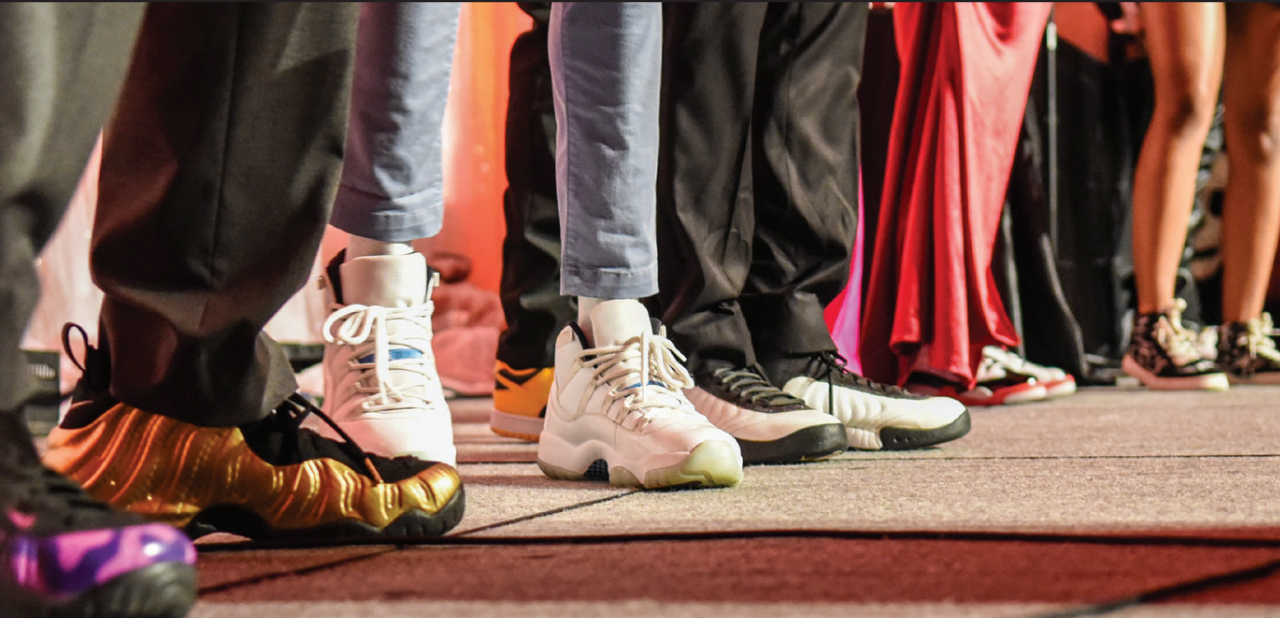Photo by Kaela Belingon
Students lining up for the outfit contest show off their sneakers at the Sneaker Ball in the Talley Ballroom on Saturday, April 8, 2023. The event, hosted by the Black Students Board, invited students to a ball wearing sneakers with their formal wear.
This year’s Pan-Afrikan Week has been quite an eventful one for many Black-identifying students and faculty. And on April 8th, the Sneaker Ball was no exception. The night was filled with dancing, outfit contests and live performances by students.
Walking in and seeing everybody dripped all the way down to their feet was an exciting sight. NC State’s Ballroom had become a glowing red mirage, an inviting environment to the sharply dressed students to come in and strut on the red carpet. Those that attended the event danced all night in their favorite sneakers, from black Air Forces to vintage Jordans.
The theme of this year’s Pan-Afrikan Week was “Black Undefined.” When asked why the BSB decided to close the week with the Sneaker Ball, Kamya Harvin, a third-year majoring in Sociology and Event Coordinator, stated, “We kinda wanted to have events that tailor to all different aspects of Blackness and we wanted to touch on different parts of Black culture.”
When asked what this year’s theme meant to them, the attendees of the Sneaker Ball had much to say. “Tonight, you’ll notice I’m rocking the Huaraches,” said second year student Tyler Lewis. “I definitely love and definitely support the theme ‘Black Undefined,” said Lewis. “To me, it means just the whole diaspora of being Black. It isn’t one specific thing.”
“For myself, I’m in my first era where I’m fully dressing as myself and I only socialize with people that restore me. It’s been a really healthy time to be whatever the f— I want,” exclaimed Kiara Bush, a fourth-year double majoring in Design Studies and Statistics.
“Black Undefined is being yourself without feeling the pressure to be one specific thing because you’re Black. Being Black doesn’t mean ‘act this way’ or ‘dress this way,’ it means being who you are while also carrying the identity of Blackness,” adds Harvin.
The rest of the night was filled with dancing, music, and a dance performance by an all Black student-led hip-hop dance group, and a vocal performance by the Ladies in Red, “NC State’s premier all-women and non-binary identifying student-led a cappella group.
It is undeniable that the ‘Hypebeast’ aesthetic has been sweeping the younger generation, and the evolution of street-style footwear has closely followed.
Nowadays, sneaker culture has arguably become about showing off wealth as much as it is a personal expression. Sneaker culture has evolved from being a staple in Black and white urban skateboarding communities, to athleisure, to now being a sign of wealth and prestige among young people and footwear enthusiasts.
Some of the most popular sneaker brands represented at the Sneaker Ball include Air Jordans, Vans and Converses among many notable others. One of the highlights of the night was the ‘Drip or Drown’ style contest hosted by DJ Lay Up, in which whoever was the most stylish participant wins a special prize.
For many of the attending students, shoes are not just an important part of completing an outfit, but sometimes make or break an outfit. Enthusiasts identify themselves as “sneakerheads” that collect sneakers as a hobby. For them, shoes are not just for practicality, but one of their main forms of self-expression.
“My shoes, they put together the whole outfit. Shoes help me match my clothes, I like color coordination,” says Ares Epps, a fifth-year majoring in Communication.
In recent years, the market price of Air Jordan’s go from as low as around $93 to $230 depending on the style and quality. Air Jordans can be seen being sported by people from all walks of life. Some of the higher end sneakers such as Kanye West’s “Yeezy” footwear are more often bought for comfort and aesthetics than practicality and accessibility.
Sneaker culture became even more mainstreamed through partnerships and ambassadorships between high profile athletes and popular athleisure and footwear brands such as Nike, Reebok, and Adidas. Most notably, Michael Jordan’s partnership with Nike not only popularized the brand itself, but also cemented Jordan’s influence in the footwear and athleisure industry. The first Air Jordan sneakers were publicly released in 1985, and has dropped a new pair every year since, even after his retirement from basketball. Other influential athletes with sneaker lines include Kobe Bryant, Steph Curry, Kevin Durant, etc.
Brands like Champion and New Balance have had a stark rebrand in the past years due to demand for more “retro” and “Y2K” style sport shoes. Both brands initially being sold by Walmart retailers back in the mid 2000s and are now items of commodity, with sneaker prices averaging $200 for New Balances, and Champion being distributed by various sportswear retailers worldwide.
Sneakers have come a long way from being the old reliable sports shoe to now becoming luxury items that many people wouldn’t even dare get dirty. Students at the Sneaker Ball had a lot to say about the ever evolving culture.
“I feel like they’re trying to advertise the brand. If something seems popular, if something’s in style, everyone’s gonna want it. So I guess it all depends if its’ in high demand or not,” says Epps.
“I definitely think capitalism has really taken a turn. I know a lot of shoes are pretty expensive and not very accessible. I know shoes like Air Force 1s and Converses didn’t use to cost that much, now I see the price going up all the time,” stated Harvin.
Popular brands like Yeezy’s often would put out very limited stock of shoes to increase demand. Hundreds of “sneakerheads” would wait outside of stores for hours, sometimes even overnight, just to get their hands on highly sought after shoes in limited quantities. The more demand, the higher the prices will go. Many so-called “resellers” take advantage of this consumer demand by buying highly anticipated sneakers in bulk and selling them for a much higher price, with some resellers profiting anywhere from $2,000 to $10,000 dollars for some designer shoes. “Obviously we want to appreciate its uniqueness and its style, but we live in America and everything is of high value. Everything is run by money,” commented Epps.
Harvin added, “You see shoes selling out before they barely hit the website and it’s costing a lot. It’s become truly a luxury item and also with different athletes, it’s definitely added to the culture of it all and kinda added to the desire for it. And you know, at least in America when things are wanted more, it becomes a little less accessible.”
The one thing that has stayed a constant is the flexibility of the sneaker to be worn comfortably in many settings, while still remaining stylish.
Sneaker culture is deeply rooted in Black Culture and its influence is not lost to the casual enjoyer. Not only were sneakers popularized by Black athletes, but the most influential brands were pioneered by them as well. The future of sneakers and luxury streetwear will continue to evolve, attracting enthusiasts and its roots in Black culture will never be lost in translation.
The Sneaker Ball was a great way to end Pan-Af Week as it brought Black students together to be treated with great food and music in a somewhat formal setting. The Sneaker Ball certainly highlighted the sneaker’s ability to look stylish with any outfit, street or formal, and our students’ ability to be bold and freely express themselves through fashion.





